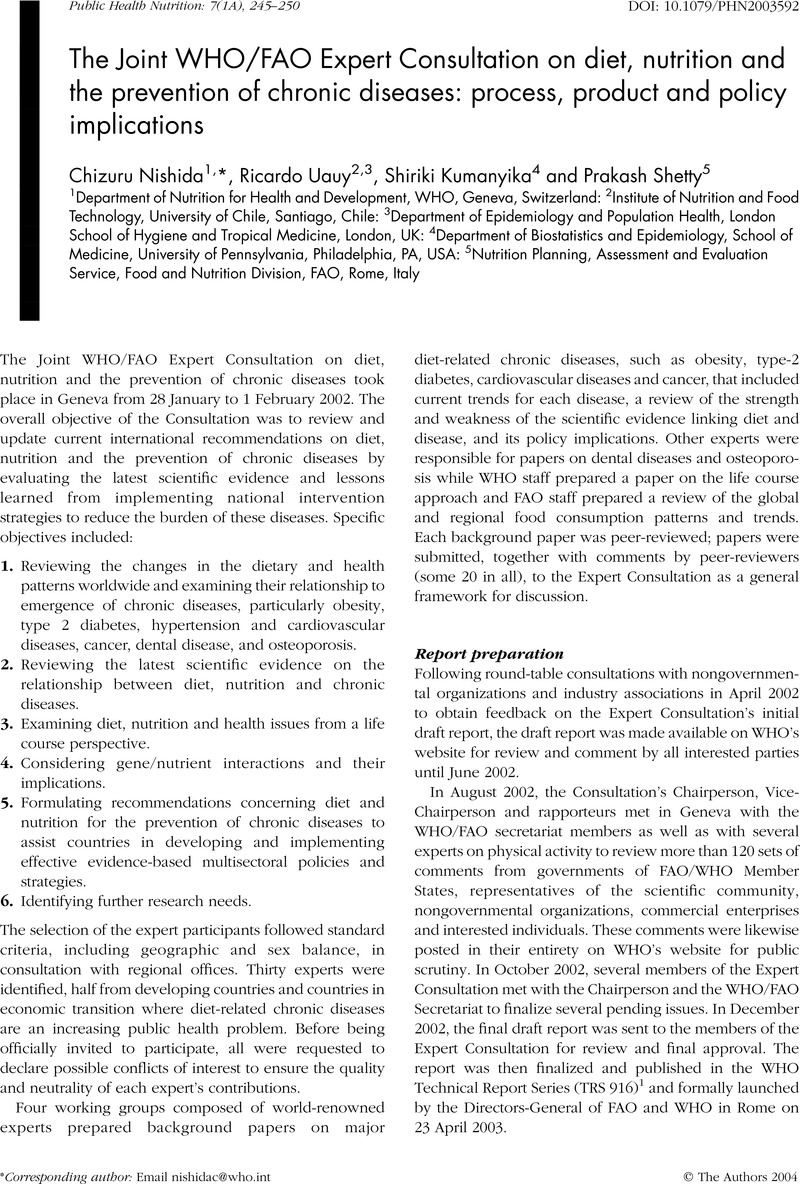Diet Based on Recommendations by Fao
Article contents
- Abstract
- References
Abstract
An abstract is not available for this content so a preview has been provided. As you have access to this content, a full PDF is available via the 'Save PDF' action button.

- Type
- Research Article
- Copyright
- Copyright © CAB International 2004
References
1 Diet, Nutrition and the Prevention of Chronic Diseases. Report of a Joint WHO/FAO Expert Consultation. WHO Technical Report Series No. 916. Geneva: World Health Organization, 2003.Google Scholar
2 Diet, Nutrition, and the Prevention of Chronic Diseases. Report of a WHO Study Group. WHO Technical Report Series No. 797. Geneva: World Health Organization, 1990.Google Scholar
3 World Cancer Research Fund. Food, Nutrition and the Prevention of Cancer: A Global Perspective. Washington, DC: American Institute for Cancer Research, 1997.Google Scholar
4 Protein and Amino acid Requirements in Human Nutrition. Report of a Joint WHO/FAO/UNU Expert Consultation. Geneva: World Health Organization, 2004 (In press).Google Scholar
5 WHO/UNICEF/ICCIDD. Recommended Iodine Levels in Salt and Guidelines for Monitoring Their Adequacy and Effectiveness. Geneva: World Health Organization, 1996 (document WHO/NUT/96.13).Google Scholar
6 Steyn, NP , Myburgh, NG , Nel, JH . Evidence to support a food-based dietary guideline on sugar consumption in South Africa. Bulletin of the World Health Organization. 2003; 81: 599–608.Google ScholarPubMed
7 Mann, J . Sugar revisited—again. Bulletin of the World Health Organization 2003; 81: 552–3.Google Scholar
8 Gay, J , et al. Dietary factors in epidemic neuropathy on the Isle of Youth, Cuba. Bulletin of the Pan American Health Organization. 1995; 29: 25–36.Google Scholar
9 Roman, GC . An epidemic in Cuba of optic neuropathy, sensorineural deafness, peripheral sensory neuropathy and dorsolateral myeloneuropathy. Journal of the Neurological Sciences 1994; 127: 11–28.CrossRefGoogle ScholarPubMed
10 Mann, JI , et al. Effects on serum-lipids in normal men of reducing dietary sucrose or starch for five months. Lancet 1970; 1: 870–2.CrossRefGoogle ScholarPubMed
11 Smith, JB , Niven, BE , Mann, JI . The effect of reduced extrinsic sucrose intake on plasma triglyceride levels. European Journal of Clinical Nutrition 1996; 50: 498–504.Google ScholarPubMed
12 Saris, WH , et al. Randomized controlled trial of changes in dietary carbohydrate/fat ratio and simple vs complex carbohydrates on body weight and blood lipids: the CARMEN study. The Carbohydrate Ratio Management in European National diets. International Journal of Obesity and Related Metabolic Disorders 2000; 24: 1310–8.CrossRefGoogle Scholar
13 Poppitt, SD , et al. Long-term effects of ad libitum low-fat, high-carbohydrate diets on body weight and serum lipids in overweight subjects with metabolic syndrome. American Journal of Clinical Nutrition 2002; 75: 11–20.CrossRefGoogle ScholarPubMed
14 Raben, A , et al. Sucrose compared with artificial sweeteners: different effects on ad libitum food intake and body weight after 10 wk of supplementation in overweight subjects. American Journal of Clinical Nutrition 2002; 76: 721–9.CrossRefGoogle ScholarPubMed
15 Ludwig, DS , Peterson, KE , Gormakaer, SL . Relation between consumption of sugar-sweetened drinks and childhood obesity: a prospective, observational analysis. Lancet 2001; 357: 505–8.CrossRefGoogle ScholarPubMed
16 Institute of Medicine of the National Academies. Dietary Reference Intakes: Energy, Carbohydrate, Fiber, Fatty acids, Cholesterol, Protein, and Amino acids. Washington, DC: The National Academies Press, 2002 (Prepublication copy).Google Scholar
17 World Declaration and Plan of Action for Nutrition. Rome, Food and Agriculture Organization of the United Nations and Geneva, World Health Organization, 1992.Google Scholar
18 Nutrition and Development: A Global Assessment. Rome, Food and Agriculture Organization of the United Nations and Geneva, World Health Organization, 1992.Google Scholar
19 Promoting appropriate diets and healthy lifestyles. In: Major Issues for Nutrition Strategies. Rome, Food and Agriculture Organization of the United Nations and Geneva, World Health Organization, 1992.Google Scholar
20 Resolution WHA 46.7. International Conference on Nutrition: follow-up action. Forty-sixth World Health Assembly, Geneva, 3–14 May 1993. Volume 1. Resolutions and Decisions, Annexes. Geneva: World Health Organization, 1993; (document WHA46/1993/REC/1).Google Scholar
21 WHO Global Database on National Nutrition Policies and Programmes. Geneva: Department of Nutrition, World Health Organization, 2003.Google Scholar
22 Preparation and Use of Food-based Dietary Guidelines. Report of a Joint FAO/WHO Consultation. WHO Technical Report Series, No. 880. Geneva: World Health Organization, 1998.Google Scholar
23 Peña, M , Molina, V . Food Based Dietary Guidelines and Health Promotion in Latin America. Washington, DC: Pan American Health Organization and Institute of Nutrition of Central America and Panama, 1999.Google Scholar
24 CINDI Dietary Guidelines. Copenhagen: World Health Organization, 2000.Google Scholar
25 Development of Food Based Dietary Guidelines for the Asian region. Final report of the recommendations of the Asian Nutrition Forum/WHO Symposium on Diet Related Chronic Diseases in Asia New Delhi, India International Centre 10–14 February 1997.Google Scholar
26 Development of Food-based Dietary Guidelines for the Western Pacific Region: The Shift from Nutrients and Food Groups to Food Availability, Traditional Cuisine and Modern Foods in Relation to Emerging Chronic Noncommunicable Diseases. Manila: WHO Regional Office for the Western Pacific, 1999.Google Scholar
Diet Based on Recommendations by Fao
Source: https://www.cambridge.org/core/journals/public-health-nutrition/article/joint-whofao-expert-consultation-on-diet-nutrition-and-the-prevention-of-chronic-diseases-process-product-and-policy-implications/9C5F92142766286FE744EA4412A53476
0 Response to "Diet Based on Recommendations by Fao"
Post a Comment